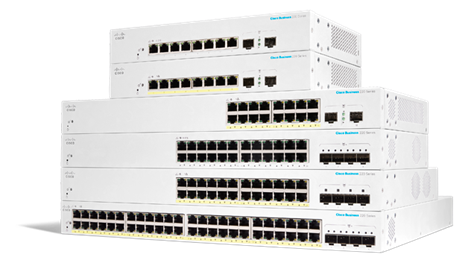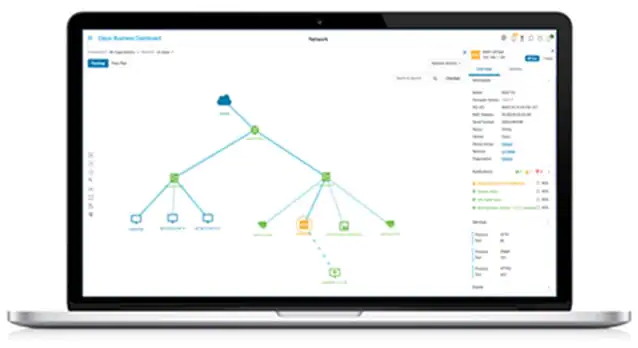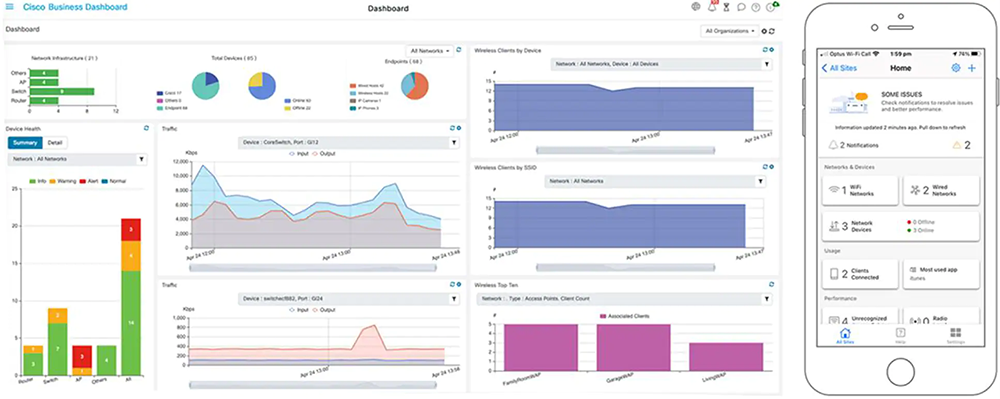| Cisco Business 220 Series Gigabit Ethernet Switches Specifications |
| Switching capacity |
Model |
Forwarding rate in millions of packets per second (mpps; 64-byte packets) |
Switching capacity in Gigabits per second (Gbps) |
| CBS220-8T-E-2G |
14.88 mpps |
20.0 Gbps |
| CBS220-8P-E-2G |
14.88 mpps |
20.0 Gbps |
| CBS220-8FP-E-2G |
14.88 mpps |
20.0 Gbps |
| CBS220-16T-2G |
26.78 mpps |
36.0 Gbps |
| CBS220-16P-2G |
26.78 mpps |
36.0 Gbps |
| CBS220-24T-4G |
41.66 mpps |
56.0 Gbps |
| CBS220-24P-4G |
41.66 mpps |
56.0 Gbps |
| CBS220-24FP-4G |
41.66 mpps |
56.0 Gbps |
| CBS220-48T-4G |
74.38 mpps |
104.0 Gbps |
| CBS220-48P-4G |
74.38 mpps |
104.0 Gbps |
| CBS220-24T-4X |
95.23 mpps |
128 Gbps |
|
CBS220-24P-4X
|
95.23
|
128 Gbps
|
|
CBS220-24FP-4X
|
95.23
|
128 Gbps
|
| CBS220-48T-4X |
130.94 |
176 Gbps |
|
CBS220-48P-4X
|
130.94
|
176
|
|
CBS220-48FP-4X
|
130.94
|
176
|
|
MAC table
|
Up to 8,192 Media Access Control (MAC) addresses |
|
Spanning Tree Protocol (STP)
|
Standard 802.1d Spanning Tree support, enabled by default Fast convergence using 802.1w (Rapid Spanning Tree [RSTP]) Multiple Spanning Tree instances using 802.1s (MSTP) 16 instances are supported |
|
Port grouping
|
Support for IEEE 802.3ad Link Aggregation Control Protocol (LACP) ● Up to 8 groups Up to 8 ports per group with 16 candidate ports for each (dynamic) 802.3ad link aggregation Load balance based on source and destination MAC address, or source and destination MAC/IP |
|
VLAN
|
Support for up to 256 Virtual Local Area Networks (VLANs) simultaneously Port-based and 802.1Q tag-based VLANs Management VLAN Guest VLAN |
|
Auto voice VLAN
|
Voice traffic is automatically assigned to a voice-specific VLAN and treated with appropriate levels of QoS |
|
QinQ VLAN
|
VLANs transparently cross a service provider network while isolating traffic among customers |
|
Generic VLAN Registration Protocol (GVRP) and Generic Attribute Registration Protocol (GARP)
|
Protocols for automatically propagating and configuring VLANs in a bridged domain |
|
Head-of-Line (HOL) blocking
|
HOL blocking prevention |
|
Jumbo frame
|
Frame sizes up to 9,216 supported |
|
Loopback detection
|
Loopback detection provides protection against loops by transmitting loop protocol packets out of ports on which loop protection has been enabled. It operates independently of STP. |
|
Automatic Media-Dependent Interface Crossover (MDIX)
|
Automatically adjusts transmit and receive pairs if an incorrect cable type (crossover or straight-through) is installed. |
| ACLs |
Drop or rate limit based on source and destination MAC, VLAN ID or IP address, protocol, port, Differentiated Services Code Point (DSCP)/IP precedence, Transmission Control Protocol (TCP)/ User Datagram Protocol (UDP) source and destination ports, 802.1p priority, Ethernet type, Internet Control Message Protocol (ICMP) packets, Internet Group Management Protocol (IGMP) packets, TCP flag
Support up to 512 rules |
| Port security |
Creates the ability to lock source MAC addresses to ports; limits the number of learned MAC addresses |
| IEEE 802.1X (authenticator role) |
802.1X: Remote Authentication Dial-in User Service (RADIUS) authentication; guest VLAN; Single-host, multiple-host, and multisession mode |
| RADIUS, TACACS+ |
Supports RADIUS and Terminal Access Controller Access Control System (TACACS) authentication; switch functions as a client |
| MAC address filtering |
Supported |
| Storm control |
Broadcast, multicast, and unknown unicast |
| DoS prevention |
Denial-of-Service (DoS) attack prevention |
| STP Bridge Protocol Data Unit (BPDU) Guard |
This security mechanism protects the network from invalid configurations. A port enabled for BPDU Guard is shut down if a BPDU message is received on that port. |
| Spanning Tree Loop Guard |
This feature provides additional protection against Layer 2 forwarding loops (STP loops). |
| Secure Shell (SSH) Protocol |
SSH is a secure replacement for Telnet traffic. SCP also uses SSH. SSH v1 and v2 are supported. |
| Secure Sockets Layer (SSL) |
SSL support: Encrypts all HTTPS traffic, allowing highly secure access to the browser-based management GUI in the switch |
| Access Control Lists (ACLs) |
Support for up to 512 rules
Drop or rate limit based on source and destination MAC, VLAN ID or IPv4 or IPv6 address, IPv6 flow label, protocol, port, Differentiated Services Code Point (DSCP)/IP precedence, TCP/UDP source and destination ports, 802.1p priority, Ethernet type, Internet Control Message Protocol (ICMP) packets, IGMP packets, TCP flag; ACL can be applied on both ingress and egress sides
Time-based ACLs supported |
| Priority levels |
8 hardware queues |
| Scheduling |
Strict priority and Weighted Round-Robin (WRR) queue assignment based on DSCP and class of service (802.1p/CoS) |
| Class of service |
Port based; 802.1p VLAN priority based; IPv4/v6 IP precedence/Type of Service (ToS)/DSCP based; Differentiated Services (DiffServ); classification and re-marking ACLs, trusted QoS |
| Rate limiting |
Ingress policer; egress shaping and rate control; per VLAN, per port, and flow based |
| Congestion avoidance |
A TCP congestion avoidance algorithm is required to reduce and prevent global TCP loss synchronization |
| Internet Group Management Protocol (IGMP) Versions 1, 2, and 3 Snooping |
IGMP limits bandwidth-intensive multicast traffic to only the requesters; supports 256 multicast groups |
| IGMP querier |
IGMP querier is used to support a Layer 2 multicast domain of snooping switches in the absence of a multicast router |
| Standards |
802.3 10BASE-T Ethernet, IEEE 802.3u 100BASE-TX Fast Ethernet, IEEE 802.3ab 1000BASE-T Gigabit Ethernet, IEEE 802.3ad LACP, IEEE 802.3z Gigabit Ethernet, IEEE 802.3x Flow Control, IEEE 802.1D (STP, GARP, and GVRP), IEEE 802.1Q/p VLAN, IEEE 802.1w RSTP, IEEE 802.1s Multiple STP, IEEE 802.1X Port Access Authentication, IEEE 802.3af, IEEE 802.3at, RFC 768, Request for Comments (RFC) 783, RFC 791, RFC 792, RFC 793, RFC 813, RFC 879, RFC 896, RFC 826, RFC 854, RFC 855, RFC 856, RFC 858, RFC 894, RFC 919, RFC 922, RFC 920, RFC 950, RFC 1042, RFC 1071, RFC 1123, RFC 1141, RFC 1155, RFC 1157, RFC 1350, RFC 1533, RFC 1541, RFC 1624, RFC 1700, RFC 1867, RFC 2030, RFC 2616, RFC 2131, RFC 2132, RFC 3164, RFC 3411, RFC 3412, RFC 3413, RFC 3414, RFC 3415, RFC 2576, RFC 4330, RFC 1213, RFC 1215, RFC 1286, RFC 1442, RFC 1451, RFC 1493, RFC 1573, RFC 1643, RFC 1757, RFC 1907, RFC 2011, RFC 2012, RFC 2013, RFC 2233, RFC 2618, RFC 2665, RFC 2666, RFC 2674, RFC 2737, RFC 2819, RFC 2863, RFC 1157, RFC 1493, RFC 1215, RFC 3416 |
| IPv6 |
IPv6 host mode
IPv6 over Ethernet
Dual IPv6/IPv4 stack
IPv6 Neighbor and router Discovery (ND)
IPv6 stateless address auto configuration
Path Maximum Transmission Unit (MTU) discovery
Duplicate Address Detection (DAD)
Internet Control Message Protocol (ICMP) version 6 |
| IPv6 QoS |
Prioritize IPv6 packets in hardware |
| IPv6 ACL |
Drop or rate limit IPv6 packets in hardware |
| Multicast Listener Discovery (MLD v1/2) snooping |
Deliver IPv6 multicast packets only to the required receivers |
| IPv6 applications |
Web/SSL, Telnet server/SSH, Ping, Traceroute, Simple Network Time Protocol (SNTP), Trivial File Transfer Protocol (TFTP), Simple Network Management Protocol (SNMP), Remote Authentication Dial-In User Service (RADIUS), Syslog, DNS client, DHCP client, DHCP autoconfig |
| IPv6 RFCs supported |
RFC 4443 (which obsoletes RFC 2463): ICMPv6
RFC 4291 (which obsoletes RFC 3513): IPv6 address architecture
RFC 4291: IPv6 Addressing Architecture
RFC 2460: IPv6 Specification
RFC 4861 (which obsoletes RFC 2461): Neighbor Discovery for IPv6
RFC 4862 (which obsoletes RFC 2462): IPv6 Stateless Address Autoconfiguration
RFC 1981: Path MTU Discovery
RFC 4007: IPv6 Scoped Address Architecture
RFC 3484: Default address selection mechanism |
| Cisco Business Dashboard |
Support for embedded probe for Cisco Business Dashboard running on the switch. Eliminates the need to set up a separate hardware or virtual machine for the Cisco Business Dashboard Probe on site. |
| Cisco Business mobile app |
Mobile app for Cisco Business Switch and Wireless products. Helps to set up a local network in minutes and provide easy management at your fingertips. |
| Cisco Network Plug and Play (PnP) agent |
The Cisco Network Plug and Play solution provides a simple, secure, unified, and integrated offering to ease new branch or campus device rollouts or for provisioning updates to an existing network. The solution provides a unified approach to provision Cisco routers, switches, and wireless devices with a near-zero-touch deployment experience.
Supports Cisco PnP Connect |
| Web user interface |
Built-in switch configuration utility for easy browser-based device configuration (HTTP/HTTPS). Supports configuration, wizards, system dashboard, system maintenance, and monitoring
Basic and advanced mode for maximum operational efficiency |
| Text-editable config files |
Config files can be edited with a text editor and downloaded to another switch, facilitating easier mass deployment |
| Command-line interface |
Scriptable CLI; a full CLI is supported. User privilege levels 1 and 15 are supported for the CLI |
| SNMP |
Simple Management Network Protocol (SNMP) versions 1, 2c, and 3 with support for traps, and SNMP version 3 User-based Security Model (USM) |
| Standard MIBs |
MIB-II (RFC1213)
IF-MIB (RFC2863)
Bridge-MIB (RFC4188)
Bridge-MIB-Extension (RFC2674)
RMON (RFC2819)
Etherlike MIB (RFC3635)
Radius Client MIB (RFC2618)
Entity MIB (RFC2737)
POWER-ETHERNET-MIB (RFC3621)
Syslog MIB (RFC3164) |
Generic Traps MIB (RFC1215)
SNMP-COMMUNITY-MIB
SNMP-MIB
LLDP-MIB
LLDP-EXT-MED-MIB
IEEE8023-LAG-MIB
CISCO-PORT-SECURITY-MIB
CISCO-ENVMON-MIB
CISCO-CDP-MIB
CISCO-CONFIG-COPY-MIB |
| Remote monitoring (RMON) |
Embedded RMON software agent supports 4 RMON groups (history, statistics, alarms, and events) for enhanced traffic management, monitoring, and analysis |
| IPv4 and IPv6 dual stack |
Coexistence of both protocol stacks to ease migration |
| Firmware upgrade |
Web browser upgrade (HTTP/HTTPS) and TFTP and upgrade over SCP running over SSH
Dual images for resilient firmware upgrades |
| Port mirroring |
Traffic on a port can be mirrored to another port for analysis with a network analyzer or RMON probe. Up to 4 source ports can be mirrored to one destination port |
| DHCP (Option 12, 66, 67, 82, 129, and 150) |
DHCP options facilitate tighter control from a central point (DHCP server) to obtain IP address, auto-configuration (with configuration file download), DHCP relay, and hostname |
| Time synchronization |
Simple Network Time Protocol (SNTP) |
| Login banner |
Configurable multiple banners for web as well as CLI |
| Other management |
HTTP/HTTPS; TFTP upgrade; DHCP client; Bootstrap Protocol (BOOTP); cable diagnostics; ping; traceroute; syslog |
| Bonjour |
The switch advertises itself using the Bonjour protocol |
| Link Layer Discovery Protocol (LLDP) (802.1ab) with LLDP-MED Extensions |
LLDP allows the switch to advertise its identification, configuration, and capabilities to neighboring devices that store the data in a MIB. LLDP-MED is an enhancement to LLDP that adds the extensions needed for IP phones. |
| Cisco Discovery Protocol |
The switch advertises itself using the Cisco Discovery Protocol. Displays brief information for connected Cisco network devices, IP phones, and wireless access points |
| EEE compliant (802.3az) |
Support 802.3az Energy Efficient Ethernet on all ports; substantially reduce the power consumption when link bandwidth is not at full utilization |
| Energy detect |
Automatically turns power off on RJ-45 port when detecting link down. Active mode is resumed without loss of any packets when the switch detects the link is up |
| Disable port LEDs |
LEDs can be manually turned off to save on energy |
| Time-based PoE |
PoE power can be on or off based on user-defined schedule to save energy. |
| Time-based port operation |
Link up or down based on user-defined schedule (when the port is administratively up) |
| 802.3af PoE or 802.3at PoE+ delivered over any of the RJ-45 network ports within the listed power budgets |
Switches support 802.3af, 802.3at, and Cisco pre-standard (legacy) PoE with maximum power of 30 W per port.
This applies to the following PoE-enabled models; the maximum number of ports providing PoE power simultaneously is determined by the total PoE budget for the switch listed as below: |
| CBS220-8P-E-2G |
65W |
8 |
| CBS220-8FP-E-2G |
1300W |
8 |
| CBS220-16P-2G |
130W |
16 |
| CBS220-24P-4G |
195W |
24 |
| CBS220-24FP-4G |
382W |
24 |
| CBS220-48P-4G |
382W |
48 |
| CBS220-24P-4X |
195W |
24 |
| CBS220-24FP-4X |
382W |
24 |
| CBS220-48P-4X |
382W |
48 |
| CBS220-48FP-4X |
740W |
48 |
| Pre-standard PoE |
Support Cisco Pre-Standard PoE |
| Intelligent PoE power management |
Support the granular power negotiation with CDP/LLDP communication with PD devices after IEEE classification |
| Buttons |
Reset button |
| Cabling type |
Unshielded Twisted Pair (UTP) Category 5 or better for 10BASE-T/100BASE-TX; UTP Category 5
Ethernet or better for 1000BASE-T |
| LEDs |
System, Link/Act, Speed |
| Flash |
64 MB |
| CPU memory |
256 MB |
| CBS220-8T-E-2G |
10 Gigabit Ethernet |
8 Gigabit Ethernet |
2 Gigabit Ethernet Small form-factor pluggable (SFP) |
| CBS220-8P-E-2G |
10 Gigabit Ethernet |
8 Gigabit Ethernet |
2 Gigabit Ethernet SFP |
| CBS220-8FP-E-2G |
10 Gigabit Ethernet |
8 Gigabit Ethernet |
2 Gigabit Ethernet SFP |
| CBS220-16T-2G |
18 Gigabit Ethernet |
16 Gigabit Ethernet |
2 Gigabit Ethernet SFP |
| CBS220-16P-2G |
18 Gigabit Ethernet |
16 Gigabit Ethernet |
2 Gigabit Ethernet SFP |
| CBS220-24T-4G |
28 Gigabit Ethernet |
24 Gigabit Ethernet |
4 Gigabit Ethernet SFP |
| CBS220-24P-4G |
28 Gigabit Ethernet |
24 Gigabit Ethernet |
4 Gigabit Ethernet SFP |
| CBS220-24FP-4G |
28 Gigabit Ethernet |
24 Gigabit Ethernet |
4 Gigabit Ethernet SFP |
| CBS220-48T-4G |
52 Gigabit Ethernet |
48 Gigabit Ethernet |
4 Gigabit Ethernet SFP |
| CBS220-48P-4G |
52 Gigabit Ethernet |
48 Gigabit Ethernet |
4 Gigabit Ethernet SFP |
| CBS220-24T-4X |
24 Gigabit Ethernet + 4 10 Gigabit Ethernet |
24 Gigabit Ethernet |
4 10G SFP+ |
|
CBS220-24P-4X
|
24 Gigabit Ethernet + 4 10 Gigabit Ethernet |
24 Gigabit Ethernet |
4 10G SFP+ |
|
CBS220-24FP-4X
|
24 Gigabit Ethernet + 4 10 Gigabit Ethernet |
24 Gigabit Ethernet |
4 10G SFP+ |
| CBS220-48T-4X |
48 Gigabit Ethernet + 4 10 Gigabit Ethernet |
48 Gigabit Ethernet |
4 10G SFP+ |
|
CBS220-48P-4X
|
48 Gigabit Ethernet + 4 10 Gigabit Ethernet |
48 Gigabit Ethernet |
4 10G SFP+ |
|
CBS220-48FP-4X
|
48 Gigabit Ethernet + 4 10 Gigabit Ethernet |
48 Gigabit Ethernet |
4 10G SFP+ |
| Packet buffer |
All numbers are aggregate across all ports because the buffers are dynamically shared. |
| CBS220-8T-E-2G |
4.1 Mb |
| CBS220-8P-E-2G |
4.1 Mb |
| CBS220-8FP-E-2G |
4.1 Mb |
| CBS220-16T-2G |
4.1 Mb |
| CBS220-16P-2G |
4.1 Mb |
| CBS220-24T-4G |
4.1 Mb |
| CBS220-24P-4G |
4.1 Mb |
| CBS220-24FP-4G |
4.1 Mb |
| CBS220-48T-4G |
12 Mb |
| CBS220-48P-4G |
12 Mb |
| CBS220-24T-4X |
12 Mb |
| CBS220-24P-4X |
12 Mb |
| CBS220-24FP-4X |
12 Mb |
| CBS220-48T-4X |
16 Mb |
| CBS220-48P-4X |
16 Mb |
| CBS220-48FP-4X |
16 Mb |
| Supported SFP modules |
SKU |
Media |
Speed |
Maximum distance |
| MGBSX1 |
Multimode fiber |
1000 Mbps |
500 m |
| MGBLX1 |
Single-mode fiber |
1000 Mbps |
10 km |
| MGBLH1 |
Single-mode fiber |
1000 Mbps |
40 km |
| MGBT1 |
UTP cat 5 |
1000 Mbps |
100 m |
| GLC-SX-MMD |
Multimode fiber |
1000 Mbps |
550 m |
| GLC-LH-SMD |
Single-mode fiber |
1000 Mbps |
10 km |
| GLC-BX-U |
Single-mode fiber |
1000 Mbps |
10 km |
| GLC-BX-D |
Single-mode fiber |
1000 Mbps |
10 km |
| GLC-TE |
UTP cat 5e |
1000 Mbps |
100 m |
| SFP-H10GB-CU1M |
Copper coax |
10 Gig |
1 m |
| SFP-10G-SR |
Multimode fiber |
10 Gig |
26 m - 400 m |
| SFP-10G-LR |
Single-mode fiber |
10 Gig |
10 km |
| SFP-10G-SR-S |
Multimode fiber |
10 Gig |
26 m - 400 m |
| SFP-10G-LR-S |
Single-mode fiber |
10 Gig |
10 km |










